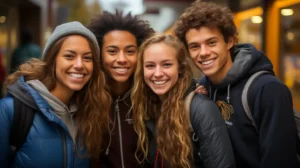Ice breaker activities play a crucial role in high schools by assisting students in breaking down social obstacles and cultivating a community atmosphere. These activities are exceptionally beneficial at the start of the academic year or when forming new groups, promoting communication and making it easier for students to acquaint themselves with one another. By employing a range of dynamic activities, ice breakers have the power to unite a collection of individuals into a unified team eager to work and study as one.
Ice Breaker Activities for High School Students

Many educators and group leaders search for creative and age-appropriate ice breakers that resonate with teens. High school students often respond best to activities that balance fun with a sense of purpose, steering clear of being overly childish or patronizing. Incorporating ice breakers that utilize teamwork, personal expression, and problem-solving can significantly enhance their comfort and involvement in group settings.
Selecting the right ice breaker is about understanding the dynamics of the group and the individuals within it. Activities can range from simple question-and-answer games to more intricate challenges that invoke critical thinking and creativity. When chosen wisely, ice breakers reduce anxiety, promote positive group dynamics, and create a productive and engaging classroom or group environment.
Exploring Ice Breaker Activities

Ice breaker activities in high school settings nurture a sense of community and comfort, paving the way for students to engage enthusiastically in the learning process.
Importance of Ice Breakers
Ice breakers are crucial because they build a positive classroom environment. Teachers utilize these activities to create an atmosphere of trust and inclusivity, essential for students to feel at ease with their peers. Such an environment promotes open communication and collaboration, furthering the goal of building meaningful relationships among high school students.
Types of Ice Breaker Activities
- Introductory Ice Breakers: These encourage students to share fun facts about themselves, facilitating initial discussions and memory connections.
- Physical Movement Ice Breakers: Activities like a “Snowball Fight,” where students write and toss questions to one another, get students moving and talking, energizing the classroom.
- Collaborative Drawing: A seating plan can be interactive with collaborative drawing exercises, promoting teamwork and critical thinking.
Techniques for Effective Implementation
- Clear Instructions: Educators should give concise and clear instructions to ensure all students understand the icebreaker activities.
- Timed Participation: Utilizing a timer can help maintain a dynamic pace and encourage participation from every student, making the session inclusive.
- Follow-up Discussions: To solidify the relationships formed during icebreakers, teachers should facilitate follow-up discussions to deepen student connections.
In their efforts to break the ice, educators should select activities that cater to their audience and align with their educational goals. They should always foster a friendly and supportive atmosphere where every student feels valued and ready to contribute.
Ice Breaker Games and Creative Dynamics

Introducing ice breaker activities is key to easing students into a new environment, fostering a sense of community, and bringing a dash of fun to their school life. Let’s explore various types of ice breakers that encourage students to open up and connect with their peers.
Question and Answer Activities
Who Am I? is an engaging game in which students pick a card with a personality or character and answer yes or no questions to guess the identity on their card. This stimulates communication and curiosity. Similarly, Icebreaker Questions offer a range of queries, such as “What’s your favorite memory with friends?” or “If you were an art piece, which one would you be?” to spark dialogue. Would You Rather poses dilemmas that get students thinking and laughing about hypotheticals.
- Example of “Would You Rather” question: Would you rather have a gigantic snowball fight or be stranded on a desert island with all your new friends?
Interactive and Movement-Based Games
Movement is an excellent way to break the ice. Streets and Alleys involves students forming a grid of “streets” to run through, promoting laughter and energy. Blobs and Speed Dating provide dynamic ways for students to rapidly meet and interact with multiple peers, encouraging the formation of new friendships. Snowball Fight invites students to write something about themselves on a sheet of paper, crumple it up, and then have a mock snowball fight – after which they read the papers to find out who wrote what.
- Speed Friending mirrors speed dating mechanics, boosting fast connections and even faster laughter as students discover fun facts about each other.
- Interactive Bingos such as Human Bingo incorporate familiar elements with a social twist, using bingo cards filled with statements reflective of students’ experiences and interests.
Building Personal Connections
Encouraging students to share personal stories builds deeper connections. Two Truths and a Lie prompts students to share three facts, one of which is a fabrication, leaving others to guess which one it is. A simple Name Game can be transformed into a creative exercise, like Reverse Charades, where students act out each other’s hobbies or interests. For a more tactile experience, The Toilet Paper Game offers laughs as students tear off what they need, only to find out each square represents a fact they must share about themselves.
- Creating a collaborative playlist can act as a musical ‘get to know your students’ activity, where each student contributes a song and explains their choice, showing a slice of their personality and tastes.
By integrating these ice breaker games and dynamic activities, teachers can help students form meaningful bonds with peers, create a safe and inclusive environment, and enrich the school experience with creativity and joy.
Frequently Asked Questions

Icebreakers play a crucial role in strengthening classroom community and making students comfortable with one another. This section addresses popular queries about implementing these activities for high school students.
What are some engaging icebreaker games for high school students?
Engaging icebreaker games for high school students include Creative Collage, which allows students to express themselves artistically. Another favorite is Scavenger Hunts, which can involve various themes and get students to interact and explore together.
How can you effectively use icebreaker activities in a high school classroom settings?
Icebreaker activities can introduce new topics, integrate cooperative learning, and facilitate student familiarity in classroom settings. They should be planned to align with the subject matter and crafted to be inclusive, ensuring every student feels comfortable participating.
What are the best icebreaker questions to use for high school students during the first week of school?
The best icebreaker questions for high school students encourage them to share personal interests and experiences non-threateningly. Questions can range from favorite hobbies to dreams for the future, creating a platform for dialogue and connection.
What online icebreaker activities are recommended for high school students in virtual classes?
For virtual classes, online icebreaker activities can include “Virtual Show and Tell,” where students present an item of significance to the class, or interactive quizzes and games that can be played together on platforms like Kahoot or Quizlet.
If you enjoyed reading about Ice Breaker Activities for High School, check out our other articles:
- Student Council Event Ideas: Engaging and Fun Activities
- PTA Event Ideas: Fun and Engaging Activities for Your School Community
- School Event Ideas for Students: Create Unforgettable Memories
- School Event Ideas: Fun and Engaging Activities
- School Event Ideas for High School: Fun and Engaging Activities
Feel free to also check out our other Articles about School Events from the category “School Life“ and don’t forget to follow us on Pinterest.






